kent island
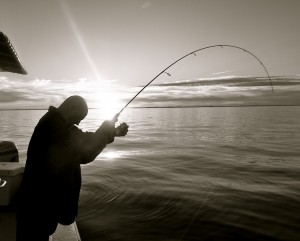 Whenever someone asks me how I feel about making striped bass a gamefish in Maryland, my answer is always the same – they already are. Light tackle anglers fish for striped bass almost the same as we would for black bass, trout, crappie, or walleye. Most of us use the same equipment. The only real difference I can see is that a few influential people in the mid-Atlantic find it profitable to commercially harvest stripers. I never heard of striped bass on a restaurant menu until I moved to Maryland. In fact, people in other parts of the country don’t consider them particularly good to eat. I cook them occasionally, but is any fish tasty enough to deserve all the controversy that surrounds striped bass? The biggest thing they have going for them is that they’re fun to catch and they’re pursued by more recreational anglers than any other species. In my book, that spells gamefish. Last week the Atlantic States Marine Fisheries Commission (ASMFC) voted down several amendments which would have increased the commercial harvest of striped bass. Maryland voted for no increase. That’s a positive sign from a state that traditionally harvests and sells more than its fair share, but it’s no reason to celebrate. Maintaining the status quo is just more bad news for the fish. Read More!
Whenever someone asks me how I feel about making striped bass a gamefish in Maryland, my answer is always the same – they already are. Light tackle anglers fish for striped bass almost the same as we would for black bass, trout, crappie, or walleye. Most of us use the same equipment. The only real difference I can see is that a few influential people in the mid-Atlantic find it profitable to commercially harvest stripers. I never heard of striped bass on a restaurant menu until I moved to Maryland. In fact, people in other parts of the country don’t consider them particularly good to eat. I cook them occasionally, but is any fish tasty enough to deserve all the controversy that surrounds striped bass? The biggest thing they have going for them is that they’re fun to catch and they’re pursued by more recreational anglers than any other species. In my book, that spells gamefish. Last week the Atlantic States Marine Fisheries Commission (ASMFC) voted down several amendments which would have increased the commercial harvest of striped bass. Maryland voted for no increase. That’s a positive sign from a state that traditionally harvests and sells more than its fair share, but it’s no reason to celebrate. Maintaining the status quo is just more bad news for the fish. Read More!
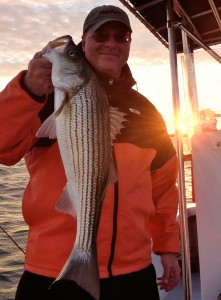 What has been will be again,
What has been will be again,
What has been done will be done again;
There is nothing new under the sun -Ecclesiastes 1:9
Since Candy Thomson published an article about my favorite jigging technique in today’s Baltimore Sun, I thought I might talk about it a little more. First, thanks to Candy for the nice write-up. She had originally planned to fish with us, but unfortunately broke a finger in a kayak accident a couple of days before. She decided to come along anyway and it was great having her, Joe, and Colin on Thunder Road for a fun evening of catching. I’m a big fan of Candy’s Outdoors Girl blog. I don’t always agree with her, but I never miss an entry. There’s no question that, despite the splint she’s wearing lately, she has her finger squarely on the pulse of outdoor issues in Maryland.
I’ll start this article by stating the obvious in that casting artificial lures for stripers using outfits made for freshwater black bass is nothing new – my father taught me to catch stripers using bass lures when I was very young. I had never heard of using heavy duty saltwater trolling gear for rockfish until I moved from Tennessee to Maryland. I was amazed and somewhat amused the first time I saw a twenty-five rod planer board trolling spread. Read More!
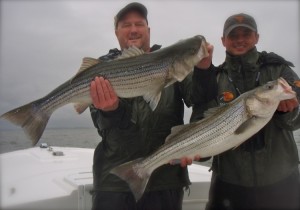 Here’s a quick update on the early-fall rockfish run we have going on now around Kent Island. I got out Thursday evening in the rain before the storm blew through. My partners were my brother-in-law Mitch and one of my regular fishing buddies, Dave. We got on the fish quickly and enjoyed an incredibly intense forty-five minutes, releasing one 30 inch rockfish after another. Mitch caught the best fish of the night, a pretty thirty-four incher. The fish turned off and we couldn’t buy another bite all night. Friday we had 30 knot winds, but we tried to fish. We couldn’t get to a lot of the places where we’ve found bigger fish, so we moved to more sheltered waters and caught only smaller ones. Saturday was a repeat of Friday with gusts up to gale force at times. We managed a few keepers and plenty of shorts in sheltered waters. Complicating things were very low water levels. North winds sometimes blow the water out of the Chesapeake basin into the Atlantic Ocean. Saturday evening’s low tide were as much as four feet below normal on the back side of Kent Island. Fortunately, conditions improved Sunday and the fish were right back where I wanted them to be. Read More!
Here’s a quick update on the early-fall rockfish run we have going on now around Kent Island. I got out Thursday evening in the rain before the storm blew through. My partners were my brother-in-law Mitch and one of my regular fishing buddies, Dave. We got on the fish quickly and enjoyed an incredibly intense forty-five minutes, releasing one 30 inch rockfish after another. Mitch caught the best fish of the night, a pretty thirty-four incher. The fish turned off and we couldn’t buy another bite all night. Friday we had 30 knot winds, but we tried to fish. We couldn’t get to a lot of the places where we’ve found bigger fish, so we moved to more sheltered waters and caught only smaller ones. Saturday was a repeat of Friday with gusts up to gale force at times. We managed a few keepers and plenty of shorts in sheltered waters. Complicating things were very low water levels. North winds sometimes blow the water out of the Chesapeake basin into the Atlantic Ocean. Saturday evening’s low tide were as much as four feet below normal on the back side of Kent Island. Fortunately, conditions improved Sunday and the fish were right back where I wanted them to be. Read More!
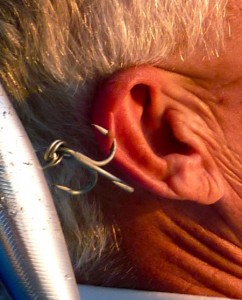 Ouch! Sunday night, my fishing partner Rich got a little too close to the top-water lure he’d left hanging on his rod in the console rod holder. The heavy duty treble hook went clean through. Even though he had mashed the barbs, it didn’t want to back out cleanly on those heavy duty saltwater hooks. More on that later….. If you’ve heard about big migratory fish with sea lice in the Bay, you heard right. I don’t know why they’re here, but I don’t see any reason to ask questions. They’re here so let’s enjoy them. I’ve fished three times since returning from my freshwater bass retreat to Tennessee. Each time we had big fish in shallow water. I’m fishing very close to home near Kent Island, sometimes within site of my house. I spent most of Saturday winterizing my boat and fishing gear. In my world, winterizing means preparing for big fish and rough water. I worked most of the day on the emergency gear in my boat but took the evening to upgrade the hooks and hardware on my top-water plugs. I also made sure I had plenty of good line on my reels, loaded my tackle bag with 10″ BKDs, and generally got things prepared for bigger fish. Saturdays are tough on the Bay, I think the fish hide on weekends, but on Sunday evening, sometimes they peek their heads out to see what’s going on. Read More!
Ouch! Sunday night, my fishing partner Rich got a little too close to the top-water lure he’d left hanging on his rod in the console rod holder. The heavy duty treble hook went clean through. Even though he had mashed the barbs, it didn’t want to back out cleanly on those heavy duty saltwater hooks. More on that later….. If you’ve heard about big migratory fish with sea lice in the Bay, you heard right. I don’t know why they’re here, but I don’t see any reason to ask questions. They’re here so let’s enjoy them. I’ve fished three times since returning from my freshwater bass retreat to Tennessee. Each time we had big fish in shallow water. I’m fishing very close to home near Kent Island, sometimes within site of my house. I spent most of Saturday winterizing my boat and fishing gear. In my world, winterizing means preparing for big fish and rough water. I worked most of the day on the emergency gear in my boat but took the evening to upgrade the hooks and hardware on my top-water plugs. I also made sure I had plenty of good line on my reels, loaded my tackle bag with 10″ BKDs, and generally got things prepared for bigger fish. Saturdays are tough on the Bay, I think the fish hide on weekends, but on Sunday evening, sometimes they peek their heads out to see what’s going on. Read More!
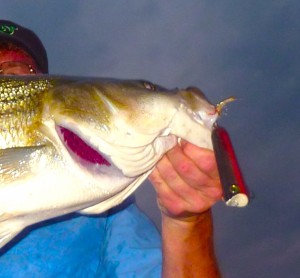 On a recent trip to my family farm in Eastern Tennessee I was rummaging though my dad’s old workshop and came across some lures he worked on. After dad passed in 1999, my brothers and I shared a lot of his fishing gear, but there was too much to take it all. During his busy lifetime that included fishing, managing bait shops and running boat docks, he collected a lot of stuff. For as long as I remember my father was a lure maker. Some of my earliest memories include opening the door to his shop and being blasted by the smothering fumes of burnt worm plastic. I still have scars from when I disobeyed, got too close to the melting pot and got splattered by hot lead. Sometimes I wonder how I’ve lived to be fifty years old considering all the chemicals I was exposed to as a child. (I also used to chew lead sinkers instead of bubble gum, but that’s another story.) Even though some of those lure making memories aren’t too pleasant, finding the old cedar blanks he started made me smile. Read More!
On a recent trip to my family farm in Eastern Tennessee I was rummaging though my dad’s old workshop and came across some lures he worked on. After dad passed in 1999, my brothers and I shared a lot of his fishing gear, but there was too much to take it all. During his busy lifetime that included fishing, managing bait shops and running boat docks, he collected a lot of stuff. For as long as I remember my father was a lure maker. Some of my earliest memories include opening the door to his shop and being blasted by the smothering fumes of burnt worm plastic. I still have scars from when I disobeyed, got too close to the melting pot and got splattered by hot lead. Sometimes I wonder how I’ve lived to be fifty years old considering all the chemicals I was exposed to as a child. (I also used to chew lead sinkers instead of bubble gum, but that’s another story.) Even though some of those lure making memories aren’t too pleasant, finding the old cedar blanks he started made me smile. Read More!
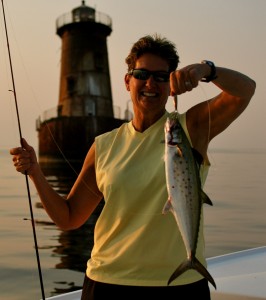 Acelerar, usted está tambaleando demasiado maldito lento. That’s Spanish for “Speed up, you’re reeling too damn slow.” Spanish Mackerel, the fastest fish in the Chesapeake have arrived in good numbers. They’re only in Maryland waters for about a month, but their arrival is something to celebrate.Fishing for Spanish is one of my favorite summer activities. The easiest way to catch them is to troll fast with in-line planers. If I just wanted to put meat in the box, that’s what I’d do. But I prefer to honor these infrequent visitors by targeting them by casting. Mack casting takes Chesapeake Bay fishing to another level. To catch Spaniards you first have to find the blitzing schools of bluefish and stripers, then turn loose of everything you’ve been doing all year, and try not to catch them. Too slow are the words most often heard on Thunder Road when we’re targeting Macks. It means someone onboard has accidentally hooked up a rockfish or a bluefish. When casting for Spanish with light spinning gear, the second most successful cast is one that doesn’t catch a thing.
Acelerar, usted está tambaleando demasiado maldito lento. That’s Spanish for “Speed up, you’re reeling too damn slow.” Spanish Mackerel, the fastest fish in the Chesapeake have arrived in good numbers. They’re only in Maryland waters for about a month, but their arrival is something to celebrate.Fishing for Spanish is one of my favorite summer activities. The easiest way to catch them is to troll fast with in-line planers. If I just wanted to put meat in the box, that’s what I’d do. But I prefer to honor these infrequent visitors by targeting them by casting. Mack casting takes Chesapeake Bay fishing to another level. To catch Spaniards you first have to find the blitzing schools of bluefish and stripers, then turn loose of everything you’ve been doing all year, and try not to catch them. Too slow are the words most often heard on Thunder Road when we’re targeting Macks. It means someone onboard has accidentally hooked up a rockfish or a bluefish. When casting for Spanish with light spinning gear, the second most successful cast is one that doesn’t catch a thing.
Spanish move up the coast from Mexico and Florida in summer months as water temperatures rise. Much more common and easier to catch down south, they reach the Chesapeake Bay in July and August. Some years they come up farther Read More!


